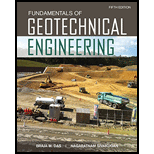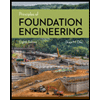
Fundamentals of Geotechnical Engineering (MindTap Course List)
5th Edition
ISBN: 9781305635180
Author: Braja M. Das, Nagaratnam Sivakugan
Publisher: Cengage Learning
expand_more
expand_more
format_list_bulleted
Concept explainers
Question
Chapter 15, Problem 15.24P
(a)
To determine
Calculate the required depth of sheet pile to be driven from the top.
(b)
To determine
Calculate the load on the tie rods.
(c)
To determine
Design a continuous anchor and show a sketch with dimensions.
Expert Solution & Answer
Want to see the full answer?
Check out a sample textbook solution
Students have asked these similar questions
A deposit of sand exhibited the following properties:
Angle of internal friction, = 35°
Dry unit weight, yd = 17 kN/m³
Saturated unit weight, Ysat = 20.7 kN/m³
will Man
59
2
=
F
20-
18.4
What is the shearing strength of the sand along a horizontal plane at a depth of
4 m given that the water table is at a depth of 2.5 m from ground surface?
Find the shear strength when the water table rises to the ground surface.
The soil profile at a road construction site is as
shown in figure (not to scale). A large embankment
is to be constructed at the site. The ground water
table (GWT) is located at the surface of the clay
layers, and the capillary rise in the sandy soil is
negligible. The effective stress at the middle of
the clay layer after the application of the
embankment loading is 180 kN/m². Take unit
weight of water, Yw =
9.81 kN/m3.
Embankment load
boudi
Sand
GWT 2m
y = 18.5 kN°
it enit
Clay
Specific gravity, G̟ = 2.65
Water content, w = 45%
Compession index, C. = 0.25
6m
%3D
%3D
Impermeable layer
The primary consolidation settlement (in m, round
off to two decimal places) of the clay layer resulting
from this loading will be
A proposed building is to have three levels of underground parking, as shown in the figure below. To
construct this building, it will be necessary to make a 10.0 m excavation, which will need to be
temporarily dewatered. The natural and dewatered groundwater tables are shown, and the medium
clay is normally consolidated. The dewatering of the area under the existing building caused an increase
in vertical effective stress.
- 28 m -
Existing building
A
B
Proposed
1.5 m building
Natural y.
Dewatered
y = 19.5 kN/mª
5 m
1.51
8.5 m
10 m
12.5 m
Sand-
(assume imcompressible)
2.5 m
Fy= 20:0 kN/m.
Medium clay C(1+ eo) = 0.26
y = 16.5 kN/m³
10.3 m
Stiff soils (assume imcompressible)
Unit weight of SAND above the water table is 19.5 KN/cum while that below the water table is 20
KN/cuM. The unit weight of CLAY is 16.5 KN/cyM.
The chief engineer is concerned that this dewatering operation may cause excessive settlement in the
adjacent building and has asked you to:
Compute for the anticipated…
Chapter 15 Solutions
Fundamentals of Geotechnical Engineering (MindTap Course List)
Ch. 15 - Prob. 15.1PCh. 15 - Prob. 15.2PCh. 15 - Prob. 15.3PCh. 15 - Prob. 15.4PCh. 15 - Prob. 15.5PCh. 15 - Prob. 15.6PCh. 15 - Prob. 15.7PCh. 15 - Prob. 15.8PCh. 15 - Prob. 15.9PCh. 15 - Prob. 15.10P
Ch. 15 - Prob. 15.11PCh. 15 - Prob. 15.12PCh. 15 - Prob. 15.13PCh. 15 - Prob. 15.14PCh. 15 - Prob. 15.15PCh. 15 - Refer to the braced cut in Figure 15.50, for which...Ch. 15 - For the braced cut described in Problem 15.16,...Ch. 15 - Refer to Figure 15.51 in which = 17.5 kN/m3, c =...Ch. 15 - Refer to Figure 15.27a. For the braced cut, H = 6...Ch. 15 - Prob. 15.20PCh. 15 - Determine the factor of safety against bottom...Ch. 15 - Prob. 15.22PCh. 15 - The water table at a site is at 5 m below the...Ch. 15 - Prob. 15.24PCh. 15 - Prob. 15.25CTPCh. 15 - Figure 15.53 below shows a cantilever sheet pile...
Knowledge Booster
Learn more about
Need a deep-dive on the concept behind this application? Look no further. Learn more about this topic, civil-engineering and related others by exploring similar questions and additional content below.Similar questions
- A footing of size 2m×2m transferring a pressure of 200 kN/m², is placed at a depth of 1.5 m below the ground as shown in the figure (not drawn to the scale). The clay stratum is normally consolidated. The clay has specific gravity of 2.65 and compression index of 0.3. 1.5m 1m 1.5 m 200 kN/m² Silty sand Clay Ya =15kN/m³ Y sat = 18kN/m³ Y sat = 17 kN/m³ GWT $0.5 m Dense sand Considering 2:1 (vertical to horizontal) method of load distribution and Y₁ = 10kN/m³, the primary consolida- tion settlement (in mm, round off to two decimal places) of the clay stratum isarrow_forward46. Consolidation of Clay: Given Exercise Figure 7.4 and the accompanying information, what is the ultimate settlement in the clay under the applied load? Note: 1 ft = 0.3048 m; 62.4 lb/ft³ = 1 Mg/m³. Assuming the sand will not settle, determine the ulti- mate settlement in the clay using: Proceeding in steps: a. Determine the effective stress for the cross section prior to loading. Show the stresses at depth using an appropriate diagram. b. What is Ao' on the clay layer caused by the imposed load? (Hint: Calculate this for the center of the clay layer at 5.8 m [19 ft] deep.) (ft) 0 c. What is the value of eo based on the original poros- ity of the clay? d. How much settlement will occur in the clay? 5 H ΔΗ =· -C log 1+- 1+e 16 22 40' o' P= 125 tons Sand: Yd=105 lb/ft³ Silty sand: Ysat Clay: Ysat=121 lb/ft³ n = 0.629, C = 0.82 Exercise Figure 7.4 = 127 lb/ft³ GWTarrow_forwardA vane 100 mm in diameter and 200 mm in heights was pressed into soft clay in a borehole. The torque was applied and gradually increased to 100 N-m when failure took place. Determine the undrain shear strength.arrow_forward
- The plan of a flexiblerectangular loaded area is shown with a uniformly distributed load q =100 KN/m2. Determine the increasein the vertical stress (A6z) at Z= 2.0 meters bel ow (a) Point A = (b) Point B= (c) Point C= 4 m 1.6 m- 2 m 0.8 m q = 100 kN/m? C 1.2 m-arrow_forwardA 5-ft fill is to be placed over the following soil profile shown below. Determine if the clay is normally consolidated or over-consolidated. The pre-consolidation pressure (past maximum consolidation stress) of the clay is 1000 lb/ft3. 5 ft 2 ft 4 ft Proposed Fill, y = 120 lb/ft³ Sand Clay Rock 2 ft A Ydry = 100 lb/ft³ Ground water table Ysat 110 lb/ft³ = o'= Pc = 1000 lb/ft²arrow_forwardFor the soil element shown below, calculate: 1- Principle stresses action on the vertical plane. 2- Principle stresses action on the 0 plane, which inclines 20° clockwise from the (horizontal plane). 25 kPa -12.5 kPa -12.5 kPa 50 kPa -20° 50 kPa y -12.5 kPa -12.5 kPa 25 kPa Xarrow_forward
- 2) Borings indicate that at a Staten Island, NY site, the top 6 meters is a loose sand with a groundwater level at 3 meters below the ground surface. Below the sand is a 12 meter thick soft clay stratum. Assume sand unit weights are ymoist = 15 kN/cubic meter and ysat = 16 kN/cubic meter. Assume clay ysat = 20 kN/cubie meter. Calculate total, pore and effective stresses at 4, 13 and 18 meters deep. %3Darrow_forwardCalculate and plot the values of stresses (o,U and o') with depth Thickness (m) 4.5 3.5 Unit Weight( KN/m) ysat= 17.8 ysat= 18.4 ysat= 19.8 Layer No. 2 3 6.0 N.G.L HI Sand, saturated by capillary action W.T. H2 Sand H3 Clav Rockarrow_forwardBorings indicate that at a Staten Island, NY site, the top 6 meters is a loose sand with a groundwater level at 3 meters below the ground surface. Below the sand is a 12 meter thick soft clay stratum. Assume sand unit weights are ymoist = 15 kN/cubic meter and ysat = 16 kN/cubic meter. Assume clay ysat = 20 kN/cubic meter. Calculate total, pore and effective stresses at 4, 13 and 18 meters deep.arrow_forward
- Plz give the correct answer. Compute the intensities of active and passive earth pressure at depth of 8 m in dry cohesionless sand with an angle of internal friction of 30 degrees , and unit weight of 18kN / (m ^ 3) What will be the intensities of active and passive pressure if the water level rises to the level? Take the saturated unit weight of sand as 22kN / (m ^ 3) .arrow_forwardAnd the void ratio for each load increment is shown in the table below. σ₂ (kPa) Void ratio 15 1.66 30 1.65 60 1.64 120 1.52 2- Find Preconsolidation pressure (oc) and compression index (Cc). 240 1.38 480 1.25arrow_forwardP.2 The borehole tecords at a level site tevealed the following details: 0 - 0.25 m Topsoil. 0.25 - 3.5 m Sand. Water table at 1.25 m. 3.5 - 10 m Clay. 10-base of borehole Impervious shale The unit weight of the topsoil and sand is 19.2 kN/m". A building is supported on a partially compensated stiff raft of dimensions 18mx ISm, with its base at 2.25 m below ground surface. The gr055 load from the taft and building 2.7 x 10° kN Calculate the settlement of the structure due to consolidation of the clay layer, whose coefficient of volume compressibility decreases lincarly from 4.2 x 10 m/kN at its top to 2.7 x 10* m'AN at its base. Use the pressure influnence chart.arrow_forward
arrow_back_ios
SEE MORE QUESTIONS
arrow_forward_ios
Recommended textbooks for you
 Fundamentals of Geotechnical Engineering (MindTap...Civil EngineeringISBN:9781305635180Author:Braja M. Das, Nagaratnam SivakuganPublisher:Cengage Learning
Fundamentals of Geotechnical Engineering (MindTap...Civil EngineeringISBN:9781305635180Author:Braja M. Das, Nagaratnam SivakuganPublisher:Cengage Learning Principles of Foundation Engineering (MindTap Cou...Civil EngineeringISBN:9781337705028Author:Braja M. Das, Nagaratnam SivakuganPublisher:Cengage Learning
Principles of Foundation Engineering (MindTap Cou...Civil EngineeringISBN:9781337705028Author:Braja M. Das, Nagaratnam SivakuganPublisher:Cengage Learning Principles of Foundation Engineering (MindTap Cou...Civil EngineeringISBN:9781305081550Author:Braja M. DasPublisher:Cengage Learning
Principles of Foundation Engineering (MindTap Cou...Civil EngineeringISBN:9781305081550Author:Braja M. DasPublisher:Cengage Learning

Fundamentals of Geotechnical Engineering (MindTap...
Civil Engineering
ISBN:9781305635180
Author:Braja M. Das, Nagaratnam Sivakugan
Publisher:Cengage Learning

Principles of Foundation Engineering (MindTap Cou...
Civil Engineering
ISBN:9781337705028
Author:Braja M. Das, Nagaratnam Sivakugan
Publisher:Cengage Learning

Principles of Foundation Engineering (MindTap Cou...
Civil Engineering
ISBN:9781305081550
Author:Braja M. Das
Publisher:Cengage Learning